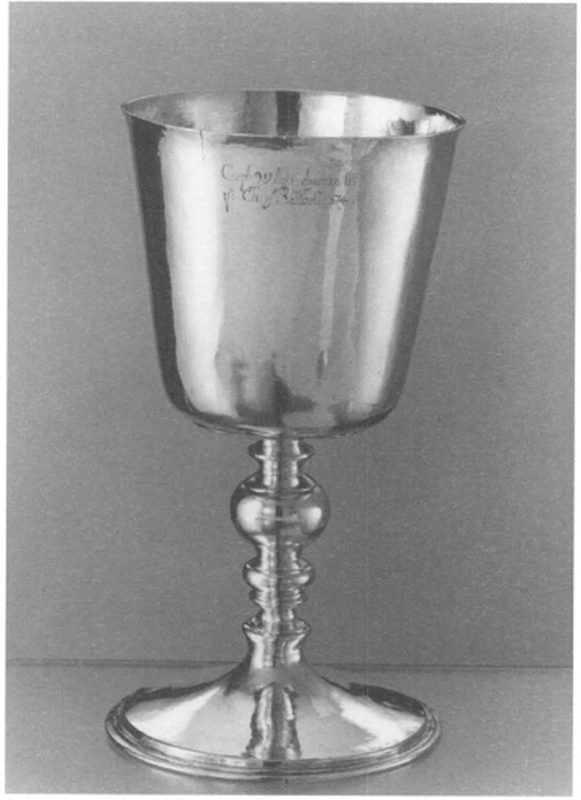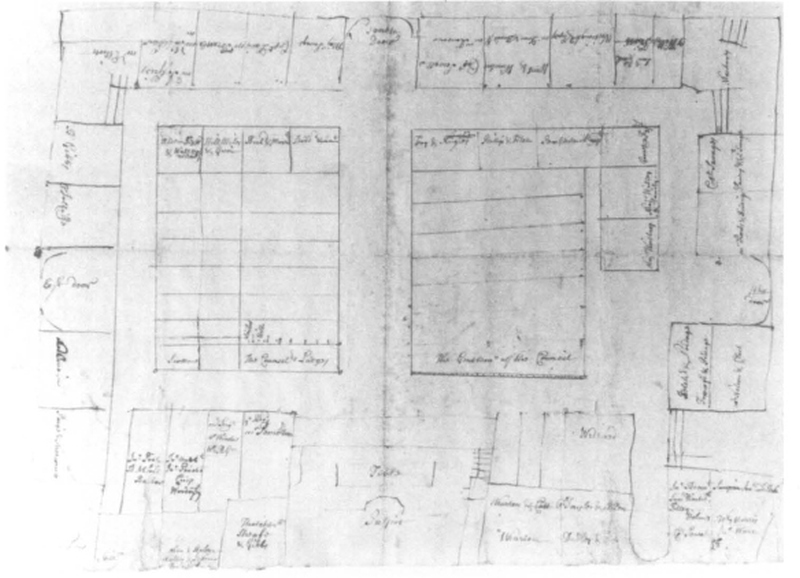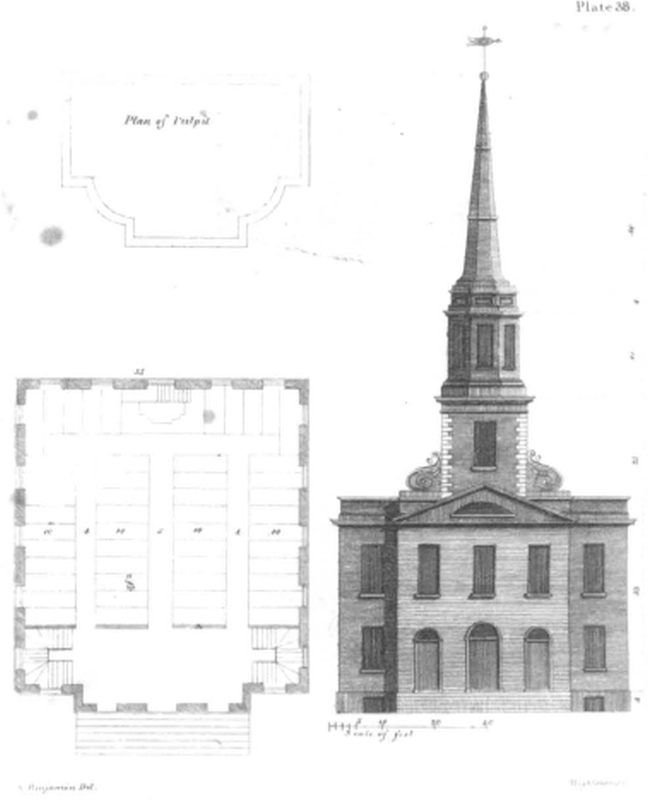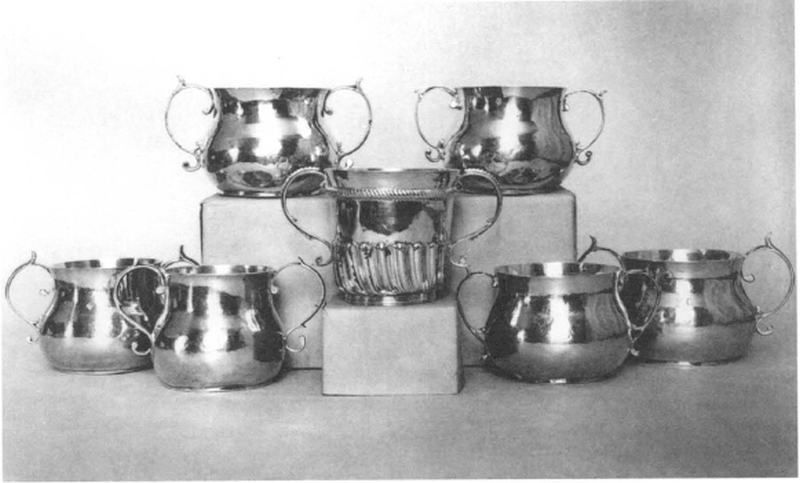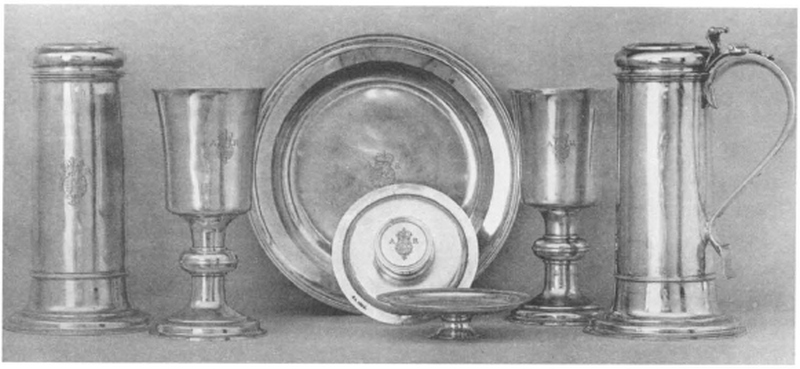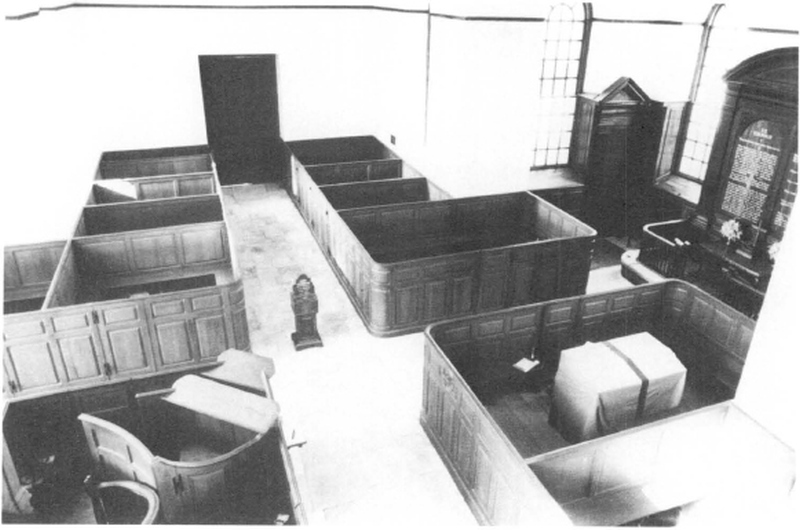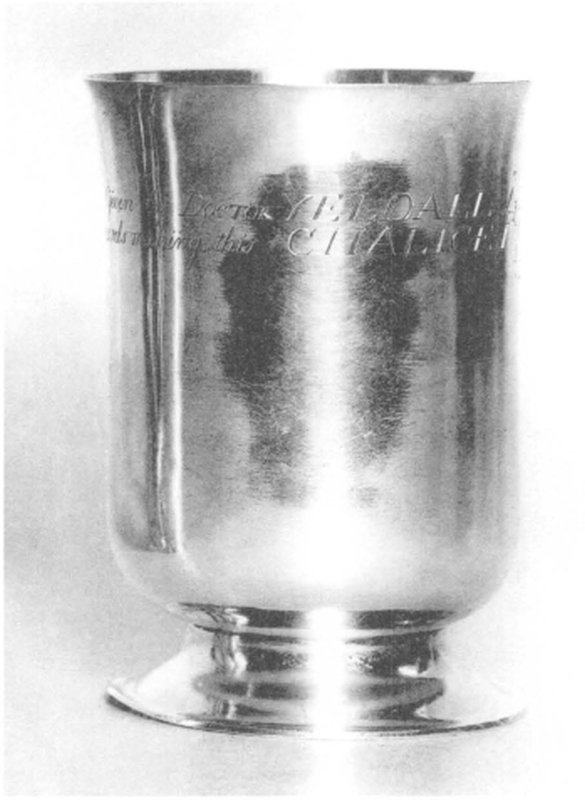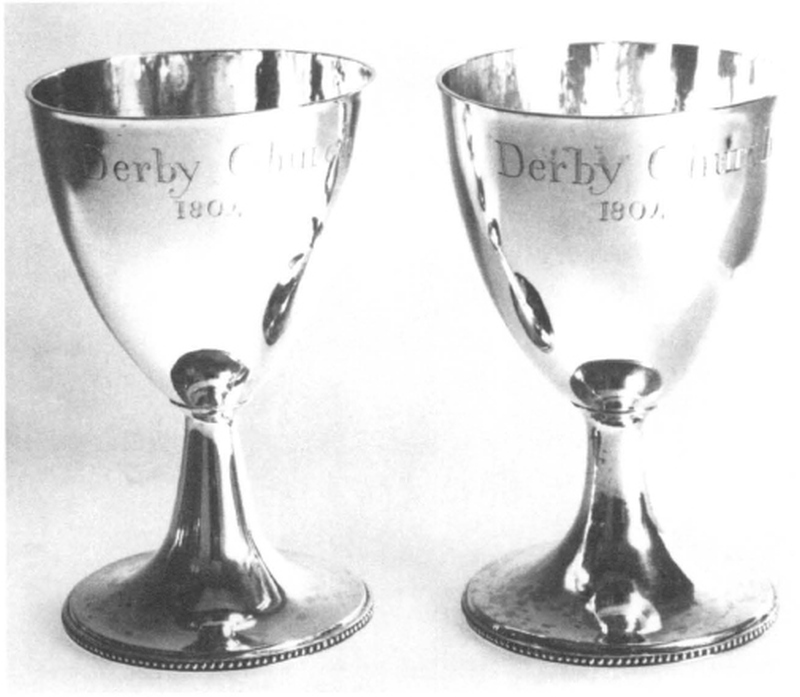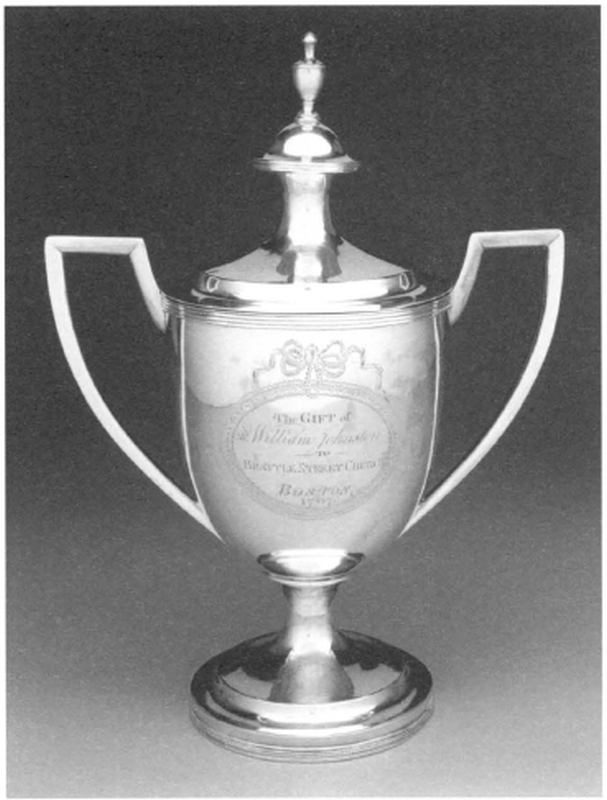Continuity and Change in New England Church Silver and Communion Practices, 1790–1840
Barbara McLean Ward
During the first half of the nineteenth century many New England churches melted down vessels from their collections of old communion plate. They used the resulting silver to have new vessels made. We do not know precisely why this was done; all we have as evidence are vague references to the practice. This paper seeks to explore why this process took place, and to analyze the forms of communion vessels made in the first half of the nineteenth century.
In 1826, at a meeting of the First Parish Church in Cambridge, Massachusetts, a committee was appointed for the purpose of obtaining more suitable plate for the communion table. At this time, the church had six tankards and four standing cups among its collection. The committee reported that:
they have caused two of the [church’s] Tankards and two cups to be recast and also two cups to be altered in such manner, as make seven cups of a uniform size and shape. They have also procured a new spoon, and six Britannia ware dishes more adapted to the use for which they are designed, than those formerly used. The expenses attendant upon these alterations and improvements have been drawn from the funds belonging to the Church, an abstract of which is hereto annexed.
|
Dr. Expense of re-casting 5 cups and altering two |
$114.41 |
|
Making seven do |
5.00 |
|
Six Britannia ware dishes |
21.00 |
|
$140.41 |
|
|
Cr. By 78 ounces of silver at 7/ per ounce |
91.00 |
|
By 48 lb. old pewter, at 18 cts. |
8.64 |
|
By Cash paid from the Church funds |
40.77 |
|
$140.41 |
Your committee are of the opinion, that by thus taking from the capital of the Church fund the sum of $40.77, they have added much to the value and convenience of the service of plate, for the future use of the Church.1
The two “altered” standing cups, on high baluster stems, were made by John Hull and Robert Sanderson of Boston about 1670, and were probably originally close in appearance to the cup made by Hull and Sanderson for the church in Rehoboth, Massachusetts (fig. 1), now in the Yale University Art Gallery. The alterations to the cups were slight, and the makers’ marks were still evident in the bowls of the refashioned cups. The silversmith merely shortened the stems of the cups and deepened the bowls.
Fig. 1. Robert Sanderson, Sr. (1608–1693) and John Hull (1624–1683), wine cup, Boston, Massachusetts, 1674. Silver; h. 75⁄16 in. Yale University Art Gallery, Mabel Brady Garvan Collection (1936.137)
What had happened to make the church members feel the need for new communion plate? Why did they believe that vessels of a different form would be more “convenient” than the old silver they already possessed? The silversmith melted the old vessels and credited the church for the value of the silver, but there was still some expense involved in making the vessels. What made the Cambridge congregation believe that these new forms were worth the trouble and expense?
The wave of refashioning communion vessels that took place in the late eighteenth and early nineteenth centuries coincides with changes in the manner and form of worship in New England’s Congregational meetinghouses. By looking closely at the material culture of worship, we gain insight into the needs, desires, priorities, and unspoken concerns of a distant generation. The following analysis rests on the conviction that objects reveal the sometimes unconscious concerns and anxieties of the people who made them or who caused them to be made.2 The choices they made when determining the arrangement of a new meetinghouse or in selecting new forms of vessels for the communion table were not random acts without significance. Each alteration of the status quo represents a new solution to a problem. The changes that took place in New England meetinghouses and their furnishings between 1780 and 1840 represent a subtle manipulation of object assemblages and formal arrangements of space that resulted in a paradigm shift in the material culture of American Protestantism.3 It is hoped that this analysis can provide fruitful material for a greater understanding of the complex interrelationship between artifact and belief—both civil and religious—and demonstrate how objects and spaces both reflected and communicated prevailing ideas about the proper order of things. Forms that appear in churches suggest that there is a connection between religious diversity and social conformity, and help us to understand why, and for what purpose, such connections may have existed.
Changes as subtle as those that transformed the look of communion vessels in the early nineteenth century can not be understood without an exploration of the material sources and their meanings. Because the meetinghouse was the stage on which the performance of repeated rituals such as communion took place, this article will begin with an examination of meetinghouse and church architecture, with a focus on New England Congregational meetinghouses, their colonial Anglican counterparts—particularly in Virginia—and the English sources that inspired them. It will then combine these insights with an analysis of the communion plate from both regions and their English sources.
In the seventeenth and eighteenth century most New England meetinghouses were unassuming structures used for both civic and religious purposes. In contrast to the parish churches the Puritan settlers had left behind in England, these were austere buildings. Stripped of the trappings of popery, such as stained glass windows, altars, and altar screens, these meetinghouses were powerful testimonies to the Puritan—and Congregationalist—belief in the power of the preaching of God’s word to effect the conversion of men and women into visible saints. The interiors of these meetinghouses, although plain, were highly structured, and their arrangement served to undergird the most important principles of the Puritan faith.
The focal point of the New England meetinghouse was the pulpit. Rising high above the pews, the pulpit put the minister in a commanding position vis-à-vis his parishioners. But lest he forget from whence his position was derived, the pews flanking the minister, and facing the main body of the congregation, were filled with the community’s most prestigious members. In the earliest meetinghouses, such as the First Church in New Haven, Connecticut, the pulpit was actually thrust into the middle of the congregation, with large pews on either side to accommodate the “chief” members of the congregation. The 1675 seating plan of Boston’s Third, or Old South Church (fig. 2), shows a building in which this seating arrangement was perpetuated.4
Fig. 2. Seating plan of Boston’s Third (“Old South”) Church, 1675. Old South Meetinghouse. Photo, Robert Blair St. George.
These square-plan meetinghouses were not consecrated or sacred structures, but served as centers of community life, and were used for town meetings and the proceedings of the Quarterly courts as well as for religious services. By their sheer size, these buildings dominated New England’s towns. The Great Awakening, and the renewed emphasis on the conversion experience that it inspired, divided many congregations and resulted in the creation of new churches. Population growth also created a need for new churches. By the mid-eighteenth century, congregations were erecting new structures dedicated to purely religious purposes, and towns were building separate townhouses and court houses to house civic activities.5 These new meetinghouses were rectangular, and had the appearance of large houses. Parishioners entered these buildings through doors on the long side of the structure, and the pulpit was placed directly across from the main entrance. Some meetinghouses had adjacent bell towers, and by the 1760s and 1770s it was becoming increasingly common for builders to construct new meetinghouses with bell towers attached to the main body of the structure. The innovative design of the 1772 North Church in Salem, which placed the main entrance under the attached bell tower, began a trend which would gather momentum after the Revolutionary War. Communion table and pulpit were now located together on the short end of the building. The pulpit was to one side or above the altar or communion table, and both occupied a central position and thus dominated the parishioner’s view as he or she entered the meetinghouse. By the time Asher Benjamin wrote his American Builder’s Companion (1806) (fig. 3), this type of church-plan meetinghouse was widespread in New England.
Fig. 3. “Plan and elevation for a meetinghouse.” From Asher Benjamin, The American Builder’s Companion; or A New System of Architecture (Boston: Etheridge and Bliss, 1806), plate 38. Courtesy, The Winterthur Library: Printed Book and Periodical Collection.
Communion vessels also underwent changes during this period. From an analysis of more than one thousand communion vessels owned by New England churches before 1780, in an earlier article I concluded that most New England congregational churches assembled groups of communion vessels that mirrored the values of their communities.6 The deacons of a Congregational church were charged with overseeing the “temporal” matters of the church’s existence, and therefore were the members who decided how to utilize gifts made to the church. In doing so, they made decisions about which objects were most appropriate or “convenient” for their congregation’s way of practicing the Lord’s Supper. Some churches collected large numbers of communion vessels because they believed in admitting nearly all adults to the communion table. But these same churches, by collecting vessels in a variety of different forms—from prestigious standing cups to simple beakers—could continue to maintain social distinctions among the communicants even as they liberalized their communion policy. Thus, the vessels perpetuated the social differentiation that also was evident in the way people were seated in the meetinghouse. In rural areas, and some urban churches known for their egalitarianism, deacons seem to have preferred to slowly amass sets of matching vessels. This trend toward uniformity would continue, and gain favor, everywhere, as the century progressed. Churches where the deacons chose to inscribe communion vessels with the names of their donors also were able to perpetuate for several generations the memory of prominent patrons of the church.
The way the South Church in Andover, Massachusetts, handled the 1802 gift of two silver flagons is perhaps an extreme example of the role of objects in maintaining ties to the past. The church minutes record that the church received two silver flagons, weighing 109 ounces “by direction” of the late Lt. Gov. Samuel Phillips and by Samuel Abbott, both members of the church. Those attending the meeting were so overcome that they decided that the church should “gratefully accept the liberal and sacred donation” and the church voted “to perpetuate the memory of the Donors and express [its] gratitude” by entering the inscription on the flagons into the church records, and directing “that they be read at every annual meeting thereof forever.”7 Other churches avoided donative inscriptions, or placed them on the undersides of the vessels, where they would not be seen, rather than giving them a prominent place on the sides of these objects. These same churches generally preferred to assemble groups of communion vessels that were all of the same general form—such as the group of communion cups, in the form of caudle cups, owned by the first church in Farmington, Connecticut (fig. 4), or the set of beakers owned by the first church in Ipswich, Massachusetts.8
In both types of Congregational churches—those that owned mixed sets of vessels, and those that had matching sets of vessels—the objects for the communion table generally were not acquired at one time, and many churches used pewter and silver objects together. Typically, a congregation first purchased pewter flagons, plates, and cups, and gradually replaced these with objects of silver.9 The first items to be acquired in silver were the various forms of vessels used to partake the communion wine. Favorite forms—most with domestic counterparts—included tankards, standing cups, two-handled cups, beakers, caudle cups, and mugs or canns. The next items to be acquired in silver were usually the flagons used to refill the “cups” with wine. And the forms most likely to be made of pewter throughout the life of a church were the plates for the communion bread. Baptismal basins, used in the only other sacrament recognized by Congregationalists, seem to have been acquired in silver only if a donor came forward to make such a gift; church members did not vote common church funds for this purpose.
Fig. 4. Silver caudle cups owned by the First Church in Farmington, Connecticut. Various Boston makers; h. (gadrooned cup) 4¼ in. From E. Alfred Jones, The Old Silver of American Churches (Letchworth, Eng.: Arden Press for the National Society of the Colonial Dames of America, 1913), plate LXI. Photo, courtesy Museum of Fine Arts, Boston.
Drinking vessels known generically as “cups,” from the use of the term in the Bible, had greater symbolic importance for Protestants than did plates for the communion bread. Communion cups helped Protestants to differentiate themselves from Roman Catholics. Roman Catholics believed that the wine was reserved for the clergy alone. The Protestant Church “restored the cup to the laity” and communicants were allowed to drink the communion wine as well as eat the communion bread. The proliferation of communion cups in Protestant churches thus was a result of the belief that all communicants should receive the wine.
Within Christian churches, there are significant differences in the way communion was practiced. In the Roman Catholic Church numerous items were required in serving the mass—such as monstrances to hold the consecrated host, censers to hold incense—but only one cup was necessary, as only the priest drank the wine. Because the priest had to consume all of the wine that was consecrated, Roman Catholic chalices tended to have a small capacity.10 Anglicans used a standard set of church plate which included a pair of chalices and patens, a pair of flagons, and an alms basin, such as the set given to Trinity Church in New York City by Queen Anne in 1709 (fig. 5).11 Because every adult in the congregation drank the communion wine, Anglican cups were commodious. These cups were filled from flagons on the church altar, and then presented to the communicants as they came forward, took the cup from the priest, drank, and returned the cup to the priest.12 In the Reformed Protestant tradition—which includes Congregationalists, Presbyterians, Baptists, Church of Scotland, and Dutch Reformed—until the mid-eighteenth century communion was restricted to those individuals who had made a relation of saving faith and had been admitted to the church as members in full communion. In these churches there was a great deal of emphasis on passing the cup among the communicants, with each person who was eligible to participate in communion receiving the cup directly from another “saved” individual. Numerous cups were used, and tankards and standing cups appear to have been reserved for use by the most prestigious members of the church, while beakers and canns were passed to the others.13
Fig. 5. Set of church silver made by Francis Garthorne of London in 1709/10, presented by Queen Anne to Trinity Church, New York City. H. (flagons) 13 in. From E. Alfred Jones, The Old Silver of American Churches (Letchworth, Eng.: Arden Press for the National Society of the Colonial Dames of America, 1913), plate CIII. Photo, courtesy Museum of Fine Arts, Boston.
In analyzing the nature of assemblages of communion vessels in New England Congregational churches, I originally decided to confine my study to churches whose earliest communion vessels dated before 1780. I did this because I noted some trends that seemed to indicate that the categories into which objects fell, and the meanings attached to certain types of objects, changed significantly after the Revolution. These changes coincided with an increase in the number of new meetinghouses being constructed with a long axis, or church plan. The coincidence of changes in both the church plans and in the form, variety, and source of communion vessels suggested that the changes were due to more than just fashion, although fashion certainly may have been a significant factor.
Discussions preserved in church records, and a close examination of the material evidence, reveal that communities defined social order in distinctly different ways. This article attempts to examine, through the use of material evidence, how the emerging emphasis on economic status in the middle of the eighteenth century was affected by revolutionary ideas and the dislocations of war. The new order of Protestant denominations in New England that followed the Revolution created diversity, but this diversity was frequently mediated by a sense of shared purpose such as in the development of broad-based nondenominational charitable organizations during the early decades of the nineteenth century.14 While this sense of shared purpose among New England’s Protestants may seem predictable for a fledgling republic, the material form this new order assumed reflects a complex interplay of Congregational and Anglican ideals.
The move toward a “church” plan in New England ecclesiastical architecture can be compared to the experience in Virginia, where the Anglican church was the established church. New England Congregationalism developed as an attempt to purify the Church of England, and early adherents made a conscious effort to differentiate their meetinghouses from the Anglican parish churches they had known at home. By contrast, Virginians drew heavily on the church forms that they knew back in England. Dell Upton, in his study of Anglican parish churches in Virginia, shows that in the earliest years of settlement, churches like St. Luke’s Church in Isle of Wight County, retained many of the elements of the Anglican parish church. In addition to an elaborate window on the chancel end of the church, St. Luke’s also utilized altar screens to visually separate the altar and choir from the congregation. By the early eighteenth century the plans used for Virginia’s Anglican churches varied considerably, with the auditory church—in which the pulpit occupies the most important position—being by far the most common. Nearly all Anglican churches in Virginia appear to have been built without towers.15 The main differences between these Anglican churches, and the traditional eighteenth-century New England meetinghouse, was that in Virginia the communion table occupied a place directly opposite at least one entrance, usually the main one, while in New England meetinghouses the pulpit occupied this prominent position. In Virginia the communion table was sometimes surrounded by special pews for communicants, and often was isolated from the main body of the church in a “communion place” which, although not a true chancel, was set off from the nave by a communion railing. The pulpit, elevated and often elaborately decorated, was usually to one side or, in cruciform churches, such as Christ Church in Lancaster County, Virginia (fig. 6), thrust into the center of the church by being placed on one corner of the intersection of the arms. These churches were expanded and altered in the nineteenth century; Upton’s research shows that many evolved so that the pulpit and communion table came to be located on the same short side of the building (with the pulpit to one side), and towers were added to the short ends of the buildings.16 The resulting plan closely resembles the “church” solution arrived at by progressive New England congregations by the turn of the nineteenth century.
Fig. 6. Interior of Christ Church in Lancaster County, Virginia. From Dell Upton, Holy Things and Profane: Anglican Parish Churches in Colonial Virginia (Cambridge, Mass.: MIT Press, 1986), 179, fig. 212. Photo, courtesy Museum of Fine Arts, Boston.
In both the New England meetinghouse and the Virginia Anglican Church, box pews (see fig. 6), with seats running around three sides, were the preferred form of seating for the most prominent members. In both New England and Virginia committees drawn from among the male members of the congregation determined who should sit where in the house of worship. This practice, known as “seating” the meetinghouse, was intended to ensure that the hierarchy established in the church mirrored the social, political, and economic hierarchy of the town or parish. Although the means of distinguishing what constituted the “best seats in the house” varied from one locale to the next, parishioners knew the meaning of the seating arrangements in their churches. By the middle of the eighteenth century, as established churches in both areas faced challenges from dissenting sects, there was an increasing tendency to raise money to build new churches by auctioning pews in the prospective building to the highest bidders. By the beginning of the nineteenth century, the old custom of seating people according to their worth to the community was set aside in favor of economic considerations. The wealthiest people could buy the seats they wanted—some could choose to remain inconspicuous, while others may have preferred prominent seats.17 Established families with less disposable income than newly arrived merchants might choose to spend a greater proportion of their income on a desirable pew, rather than risk losing status to a newcomer. What effect this may have had on social relations within towns is uncertain, and more analysis of seating plans is needed before we hilly understand the dynamics of this change. In Virginia, while pew assignments and seating were based on similar criteria to those used in New England, by the second half of the eighteenth century some leading planters were going to even greater lengths to separate themselves from the common folk during religious services. Vestry committees, dominated by one or two families, were responsible for designing and financing many of Virginia’s parish churches. Increasingly, these wealthy planters chose to seat themselves in specially built galleries that literally lifted them above their less well-to-do neighbors, and these distinctions lasted up until the Revolution.18
If we imagine what it was like to attend these houses of worship—in both New England and Virginia—we can see that every week, and in New England sometimes more than once a week, the members of a church congregation spent one or more hours face-to-face with their neighbors in a large space that was laid out as a social and economic map of their entire community. Once a congregation opted to sell pews rather than assign them, the “best pews” went to the highest bidders. Because pews were real property, they could be bought, sold, or bequeathed to one’s heirs. Under this system, prestige and power were no longer subject to periodic review, and could become hereditary. By the eve of the Revolution, in most New England towns, therefore, the “meetinghouse map” reflected whose family had money (or had had money). It was no longer the traditional measure of which citizens were thought to be the most useful and important to the town, or a guide to the most religious and pious members of the community. We have no comparable situations today, unless we might say that the common folk sit in the bleachers at Fenway Park and the influential and powerful members of the community own box seats. The arrangement in the church or meetinghouse, however, had additional power, because, existing as it did within God’s house, this enactment of social difference and social connectedness, or social distance, was backed by a conviction that such distinctions mirrored God’s plan for humankind and underscored the Bible’s message that some were meant to occupy places lower on the social ladder than others. Whether conscious or not, changes in how people were seated within their meetinghouses help us to understand how eighteenth-century New Englanders ordered the world around them, and help us to determine the nature of what they believed to be a divinely ordained social order.
On the interior, the seating plans and disposition of pews in New England churches show a subtle but significant change after the Revolution. Early Congregational seating plans, such as the 1675 plan for the Third Church in Boston, known as the Old South Church (fig. 2), show many pews that are actually behind the pulpit, in a space regarded as sanctified in English parish churches. These pews, generally reserved for the most important church members, actually faced the congregation. Dell Upton found that, in Virginia’s Anglican churches, the most important parishoners occupied the space between the communion table and the pulpit (which was usually located on an axis 45 degrees from the communion table). As in Congregational churches, these prominent members faced the less important members of the congregation during the service. Either the preparation of the communion table or the preaching of the Word, therefore, would actually take place behind some of the occupants of these pews.19 In a New England meetinghouse the most prestigious seats generally were around the outside edges of the building, and the least important seats, the benches, were located at the dead center, in what would seem to us to be the “best” seats from which to view the preacher.20 Imagine the impact of this seating arrangement, however, on a Sunday, when the people who occupied the benches found themselves confronted by the eyes of the more esteemed members of the congregation bearing down on them from all sides. By contrast, in a Virginia Anglican Church outsiders and newcomers were allowed more anonymity, being expected to occupy the seats at the rear of the nave.21
The gradual reorientation of the New England meetinghouse, and of the Virginia parish church, so that the pulpit was on one end, and all seats were oriented toward the pulpit, created a new relationship among the members of the congregation. In the New England meetinghouse the deacons and some privileged members of the congregation still faced the body of the congregation, and a few of these important church members occupied pews on either side of the pulpit, but most looked toward the minister, and toward the preaching of the word. The same change took place in Anglican parish churches in Virginia, but there, as Upton has pointed out, the most prominent members of the community not only stopped facing their neighbors, they also sometimes separated themselves completely from the rest of the community, preferring to sit literally “above” them, and “above” the clergyman.22
If we were to graph the acquisition of communion vessels by New England’s Congregational churches during the seventeenth and eighteenth centuries we would notice a slow curve upward during the first decades of settlement as new towns and new churches were established across the region. There is then a sharp rise in acquisitions during the 1720s, 1730s, and 1740s, in part because of the new evangelism of the Great Awakening and the converts it attracted, and in part because of the church schisms that occurred in the aftermath of religious fervor. There is then a sharp downward plunge in the number of vessels acquired during the next three decades. Acquisitions were particularly low during the 1770s and early 1780s, but began to increase gradually in the first years of the new republic. Another sharp upward curve occurs in the first three decades of the nineteenth century.23
To what can we attribute this new upward curve? The increase coincides with the period known as the Second Great Awakening during which large numbers of new converts became members of America’s Protestant denominations. By all accounts, however, Congregational and Unitarian churches were not the fastest growing denominations. Why then, did they add communion vessels to their possessions? Why did some churches add silver vessels while keeping older collections (sometimes quite extensive ones) virtually intact?
In having its communion vessels “recast,” the church in Cambridge did what many other New England churches would do in the early nineteenth century—the church not only increased the number of cups available for communion, it also increased the number of cups of a single form available to the church. The church in Middletown, Connecticut, for instance, decided to add several new beakers to its communion set in 1784 and 1785.24 The deacons chose a form for these six new beakers which differed from their earliest beakers in being slightly raised on a molded foot. This form also appears in Anglican churches, the most beaker-like example being this “chalice” purchased by St. James Church, New London, Connecticut, from a gift presented in 1773 (fig. 7). St. James Church gave the beaker to the Berkeley Divinity School at Yale University in the nineteenth century. This cup closely resembles the Anglican chalice form found in many Virginia churches, in that it is truncated in form and was less grand in appearance than the standing cups acquired by several New England Congregational churches in the seventeenth and early eighteenth centuries.25 By the eighteenth century many New England churches frequently chose to add to their collections chalice-like cups on high molded feet, such as the examples purchased by the First Church in Berlin, Connecticut, about 1798, or similar examples owned by the church in Derby, Connecticut (fig. 8).26
When Josiah Sartell died in 1784, the First Parish Church in Groton, Massachusetts, owned at least three silver communion vessels—a beaker, donated in 1720, and two tankards donated in 1729. Sartell bequeathed three farms to the Groton Church, as well as additional property, stipulating that the church was to use the income from these properties to support the town’s minister. The income apparently turned out to be more than sufficient for the purpose, and the church’s membership decided that some of the monies should be used to purchase seven matching silver communion cups. When Sartell’s widow died in 1790, she bequeathed a tankard and fifteen pounds for the use of the church. Even though the church already owned two tankards, the deacons decided to have Mary Sartell’s tankard melted down. They used the resulting silver, and her monetary bequest, to have five cups, similar in form to those inscribed with her husband’s name, added to the church’s collection of communion plate.27
Fig 7. “Chalice” purchased by St. James Church, New London, Connecticut, from a gift made in 1773. Made by John Gardner (active ca. 1760–75), New London, Connecticut, 1773. Silver; h. 5⅛ in. From E. Alfred Jones, The Old Silver of American Churches (Letchworth, Eng.: Arden Press for the National Society of the Colonial Dames of America, 1913), plate XCI. Photo, courtesy Museum of Fine Arts, Boston.
In 1808, Samuel Abbott bequeathed a tankard to the South Church in Andover. This tankard was large enough to make two silver cups, and the inscription was transferred to the two cups, part of a set of twelve silver cups on high stems made for the church about 1815.28 Insight into why the deacons chose such a course of action is provided by the records of the Third Church in Ipswich (Hamilton), Massachusetts. In 1790, Mary Holyoke, widow of the late Symonds Epes, left a tankard to the church. In 1821, the deacons voted to exchange the tankard for vessels of another form, “on account of its being a vessel exceedingly inconvenient for ye sisters of the church.”29 The tankard was replaced with two small canns, or mugs. The interest in accommodating the “sisters” of the church may be telling. Women were becoming more involved in the affairs of their local churches during the early nineteenth century, and may have taken a more active interest in providing the accoutrements of the communion table. Inscriptions reveal that women had always been among the donors of church plate, but after the Revolution increasing numbers of women gave communion vessels to their churches, either as life gifts, or as bequests in their wills.30
Fig. 8. Communion cups owned by the church in Derby, Connecticut. Made by Miles Gorham (active 1790–1840), New Haven, Connecticut, ca. 1804. Silver; h. 5⅝ in. From Peter Bohan and Philip Hammerslough, Early Connecticut Silver, 1700–1840 (Middletown, Conn.: Wesleyan University Press, 1970), 150–51. Photo, courtesy Museum of Fine Arts, Boston.
All of these actions, and particularly the reasons given for them, are intriguing, and perhaps instructive. During the first three decades of the nineteenth century, dozens of Congregational and emerging Unitarian churches in New England either “recast” their early communion vessels, or retained their old vessels while acquiring substantial numbers of new ones. The forms most often added by churches between 1780 and 1840 were flagons, mugs, beakers, and cups, nearly always in sets, and often by subscription of all, or a portion of, the membership. Significantly, many churches also added silver dishes or baskets for the communion bread, and baptismal basins.
The use of the words “convenient” and “suitable” appear frequently in church records in reference to the decision to take old vessels to be melted and refashioned into new ones of a different form. Clearly both qualities were taken into consideration in making these decisions, but from our modern perspective, it is not always easy to discern what these words meant in their nineteenth-century context. The members of the First Church in Hampton, New Hampshire, for instance, voted in 1744 to purchase pewter flagons with church funds, but later decided to dispose of them because they were no longer being used. In the 1780s, the church deacons apparently again changed their minds about what was suitable when they purchased four matching pewter flagons for the communion table. Four flagons could hold a significant quantity of communion wine, and the minister used these to fill the church’s small silver beakers (eight made in 1713, and four made in 1744) which were used for communion throughout the nineteenth century.31
There is some evidence that occasionally doctrinal differences may have affected decisions about the types of communion vessels a church acquired. In 1840, Deacons J. Patch and E. Annable had two mugs added to the communion service of the Third Church in Ipswich, noting that they had had their own names inscribed on the mugs “with a view to render them more secure to the ‘orthodox’ part of the Church for its use for ever.” The Church voted that “thanks be presented to the deacons for their efforts in providing the above communion furniture” and also for acquiring a wine flagon, two bread baskets, and two silver cups. It is curious that these two deacons had their own names inscribed on these pieces, as the records clearly state that church hinds from past gifts for “supplying the table” paid for the two mugs.32
Whatever the stated reasons, the cups and flagons used in these churches, though they were often made in greater numbers than the cups and flagons designated for use in Anglican churches, did come to resemble the traditional Anglican cup quite closely, and manufacturers of pewter and Britannia ware marketed standardized communion sets on the old Anglican model beginning about 1830. A set of this type was owned by the Congregational church in Springfield, Massachusetts, and a very similar set, in silver plate, was the original communion set of the John Street Methodist Church in New York City, one of the country’s oldest Methodist societies. In New England, the communion cup considered appropriate in both the Anglican Church and the Congregational Church was becoming gradually truncated in form.
The most progressive churches, such as Brattle Street Church in Boston, or the fashionable West Church in Boston which became a Unitarian Society, even added objects to their communion services that were neoclassical in form (fig. 9). These objects, derived from pagan forms, seem more to us like trophies than like church cups, and it is difficult to imagine that they were ever actually passed among the members of the congregation. The tendency to adopt a more urn-shaped form for communion purposes, however, was not confined only to the most fashionable urban churches, for we can detect a distinctly urn-like shape in cups owned by the First Church in Killingworth, Connecticut, which were purchased by the church about 1800. The Church in North Haven, Connecticut, also purchased cups on raised bases in 1804.33 All in all, the move was toward uniformity. The Anglican cup form, with a deep bowl and high foot, and the Congregational form, with high baluster stem and a smaller bowl, were gradually changing to become one form—a low-footed cup with a deep bowl. Communion vessels thus became more uniform in size and shape. The numbers of communion vessels increased in an effort to demonstrate inclusiveness. Congregational churches usually combined numerous cups of this type with one to four flagons. Anglicans—who broke with the Church of England after the Revolution and became Episcopalians—and dissenting sects like the Methodists usually had one or two cups, and practiced communion in such a way that congregants came to the front of the church and took communion directly from the minister, in keeping with the retention of an episcopal hierarchy in both denominations. The cups used by all Protestant denominations became increasingly alike, perhaps, as some have suggested, because sectarian distinctions came to mean less to Americans than a commonality of belief in a Protestant world view.
Fig. 9. Joseph Loring (1743–1815), covered cup, Boston, Massachusetts, ca. 1790–1800. Silver; h. 11⅜ in. Museum of Fine Arts, Boston, Gift of Benevolent Fraternity of Churches (13.395).
Parallels in the changes taking place in both New England and in Virginia suggest that increasing conformity in the material culture of Protestantism may have had more to do with the response of the established church to the threat of competing dissenting sects, than it had to do with theological considerations. Faced with the need to maintain prominence while being challenged by interlopers, the established churches—Congregationalists in New England and Anglicans (Episcopalians after the Revolution) in Virginia—may have been more interested than ever before in creating church edifices that physically dominated the village landscape. They may also have placed a new emphasis on portraying the church and the community as one—on demonstrating that theirs was an inclusive rather than an exclusive church. As the nineteenth century progressed the influx of Irish and other Catholic immigrant populations increasingly threatened the hegemony of the Protestant churches. In response, American Protestants came to take comfort more in their sameness than in their differences. As the established churches of the colonial period became disestablished—Massachusetts was the last to fall in the 1830s—their members may have needed to take comfort in the fact that more communion cups were needed to accommodate their many members. These sets of cups replaced the earlier communion objects in practical use—the older cups and tankards remained on view at the time of communion only to provide for modern communicants a sense of connectedness with the past, while the newer, cups were egalitarian forms equally “convenient” for both the “brothers” and “sisters” of the congregation.
Notes
1 E. Alfred Jones, The Old Silver of American Churches (Letchworth, Eng.: Arden Press for the National Society of the Colonial Dames of America, 1913), 108–9.
2 Jules David Prown, “Mind in Matter: An Introduction to Material Culture Theory and Method,” in Robert Blair St. George, ed., Material Life in America, 1600–1860 (Boston: Northeastern University Press, 1988), 17–38. Jules D. Prown, “On the Art’ in Artifacts,” from Gerald L. Pocius, ed., Living in a Material World: Canadian and American Approaches to Material Culture (St. Johns, Newfoundland: Institute of Social and Economic Research, Memorial University of Newfoundland, 1991), 144–55.
3 This discussion refers to the principles of the development of forms over time established most notably by Henri Focillon and George Kubler, as outlined in Kubler’s, The Shape of Time: Remarks on the History of Things (New Haven: Yale University Press, 1962). The paradigm shift mentioned has been chronicled by several writers on the subject of New England meetinghouse and church architecture. See especially, Philip D. Zimmerman, “Ecclesiastical Architecture in the Reformed Tradition in Rockingham County, New Hampshire, 1790–1860” (Ph.D. diss., Boston University, 1985); Kevin M. Sweeney, “Meetinghouses, Town Houses, and Churches: Changing Perceptions of Sacred and Secular Space in Southern New England, 1720–1850,” Winterthur Portfolio 28, no. 1 (Spring 1993):59–93. It is my contention that their conclusions can be said to have even broader significance if we analyze the parallel developments in architecture and the furnishings of the communion table, and see both as part of a significant shift in attitude and purpose.
4 Sweeney, “Meetinghouses, Town Houses, and Churches,” 61–62; Robert J. Dinkin, “Seating the Meetinghouse in Early Massachusetts,” in St. George, Material Life in America, 407–18; Philip D. Zimmerman, “The Lord’s Supper in Early New England: The Setting and the Service,” in Peter Benes, ed., New England Meeting House and Church: 1630–1850 (Boston: Boston University, 1979), 124–29.
5 Sweeney, “Meetinghouses, Town Houses, and Churches,” 71, 75.
6 Barbara McLean Ward, “‘In a Feasting Posture’: Communion Vessels and Community Values in Seventeenth- and Eighteenth-Century New England,” Winterthur Portfolio 23, no. 1 (Spring 1988): 1–24.
7 Jones, Old Silver of American Churches, 4–5.
8 Jones, Old Silver of American Churches, 178–79 (pl. LXI) and 222–26 (pl. LXXVIII).
9 Jones, Old Silver of American Churches, 178–79 (pl. LXI) and 222–26 (pl. LXXVIII).
10 Heith Roehig Kaufmann and Elaine K. Bryson, Eucharistic Vessels of the Middle Ages (Cambridge, Mass.: Busch-Reisinger Museum, 1975).
11 Jones, Old Silver of American Churches, 332–33, pl. CIII.
12 Charles Oman, English Church Plate, 597–1830 (London: Oxford University Press, 1957).
13 E. Brooks Holifield, The Covenant Sealed: The Development of Puritan Sacramental Theology in Old and New England, 1570–1720 (New Haven and London: Yale University Press, 1974), 109–68.
14 Conrad Edick Wright, The Transformation of Charity in Postrevolutionary New England (Boston: Northeastern University Press, 1992), 77–95.
15 Dell Upton, Holy Things and Profane: Anglican Parish Churches in Colonial Virginia (Cambridge, Mass.: MIT Press, 1986), 56–57, 61. The only church known to have been built with an integral tower was St. Luke’s Church, Isle of Wight County, Va., which Upton dates to 1685. Upton illustrates the variety of church plans common in Virginia on p. 97 (fig. 117).
16 Upton, Holy Things, 47–98; Christ Church, Lancaster County is discussed on pp. 84–85; fig. 90 is a floor plan of the church.
17 Dinkin, “Seating the Meetinghouse,” 410–15.
18 Upton, Holy Things, 186–88, 222–25.
19 Upton, Holy Things, 186–88.
20 See seating plans illustrated in Dinkin, “Seating the Meetinghouse,” 409–16, and seating plans in the Records of the First Congregational Church, Hampton, N.H., in the possession of the church.
21 Upton, Holy Things, 186–87.
22 Upton, Holy Things, 222–25.
23 This analysis is based principally on the data provided by Jones, Old Silver of American Churches.
24 Jones, Old Silver of American Churches, 281–84 (pl. XCI).
25 Jones, Old Silver of American Churches, 284–85 (pl. XCI); Church Silver of Colonial Virginia (Richmond, Va.: Virginia Museum, 1970).
26 Jones, Old Silver of American Churches, 139–40, 232–33; Peter Bohan and Philip Hammerslough, Early Connecticut Silver, 1700–1840 (Middletown, Conn.: Wesleyan University Press, 1970), 126–27, 150–51.
27 Jones, Old Silver of American Churches, 190–92 (pl. LXLX).
28 Jones, Old Silver of American Churches, 3–4.
29 Jones, Old Silver of American Churches, 196–97 (pl. LXLX).
30 Based on figures compiled from Jones, Old Silver of American Churches.
31 Records of the First Congregational Church, Hampton, N.H., in the possession of the church.
32 As quoted in Jones, Old Silver of American Churches, 197.
33 Jones, Old Silver of American Churches, 357–58; Bohan and Hammerslough, Early Connecticut Silver, 138–39.

